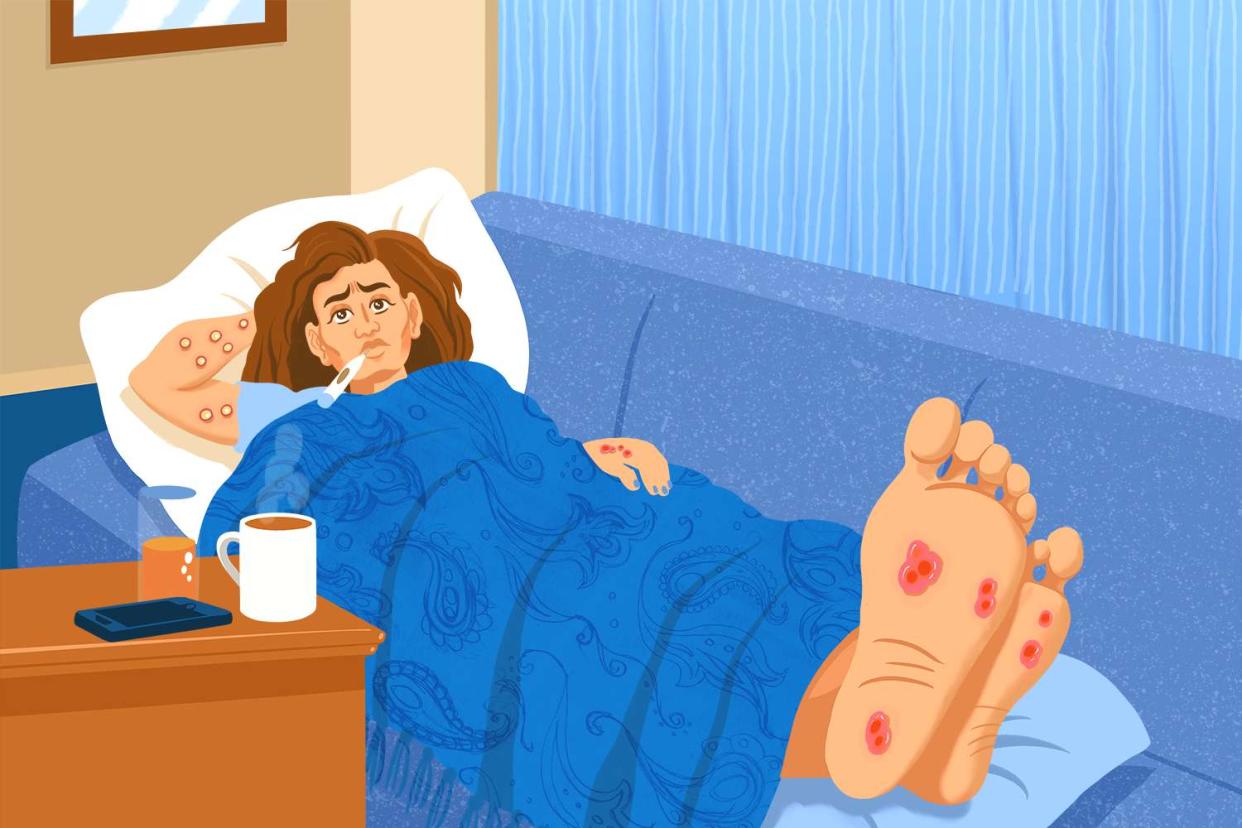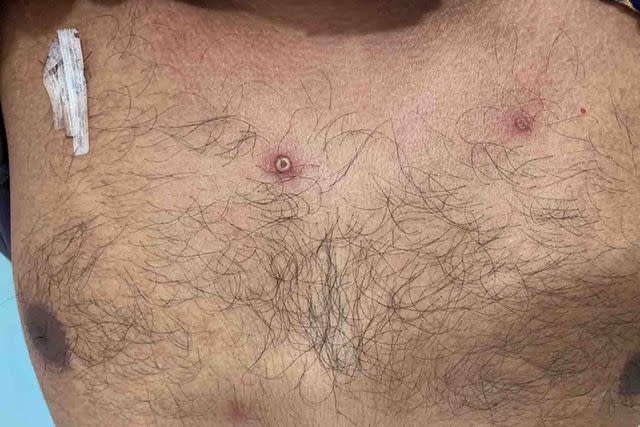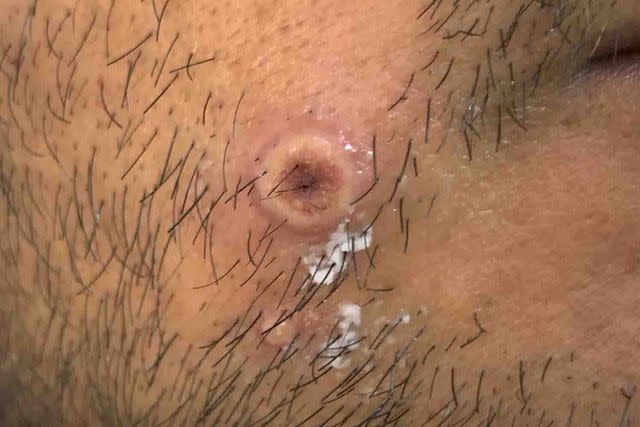What Does an Mpox Rash Look Like?

Verywell Health / Ellen Lindner
Fact checked by Nick Blackmer
Key Takeaways
Mpox lesions can occur anywhere on the body.
Lesions will look similar to pimples or blisters, but have some key differences in size, color, and feel.
Mpox (monkeypox) pictures can give you an idea of what this rash looks like. The rash is a visible symptom of the mpox virus, which is spreading through the United States.
Mpox manifests in a variety of ways, progressing from systemic symptoms like a fever and swelling to dermatological symptoms like lesions. These lesions are the most common symptom of mpox and can look similar to pimples, blisters, chickenpox, smallpox, and more.
In this article, you'll see pictures of mpox lesions and learn about the unique characteristics that can help you identify them. You'll also discover which other health conditions can look like mpox and when it's time to see a healthcare provider for a diagnosis.

UK Health Security Agency / CDC
Six different manifestations of monkeypox lesionsStages of an Mpox Rash
According to the Centers for Disease Control and Prevention (CDC), mpox lesions evolve through stages. These stages are:
Enanthem: Lesions may first form on the tongue and in the mouth, but not everyone gets them.
Macules: Macular (flat) lesions may appear for one to two days.
Papules: The macular lesions generally turn into papular (raised) lesions over a period of one to two days.
Vesicles: Next, these papular lesions become vesicular, or filled with clear fluid. This stage also typically lasts one to two days.
Pustules: The vesicular lesions often then become pustular, meaning the clear fluid has become opaque. Pustular lesions will be sharply raised, usually round, and firm to the touch. Eventually they can develop a depression in the center, which is called umbilication. Pustules will last for about five to seven days before they start to crust.
Scabs: Crusting and scabbing over of the pustules usually occur by the end of the second week. Scabs may last for a week before they start to fall off. This stage lasts for about seven to 14 days.
Which Body Parts Are Affected?
While they can crop up anywhere on the body, mpox lesions have been frequently identified on the genitals, hands, feet, chest, and face during this particular outbreak. They can also appear inside the body on mucosal surfaces like the mouth, anus, or vagina.
The images below show how lesions may appear on the chest and face.

Reproduced with permission from © DermNet New Zealand www.dermnetnz.org 2023.
Symptoms of Mpox
If you have mpox, you may have all or only a few symptoms. Symptoms can appear for up to 21 days after the day you were exposed to the virus. Here are typical symptoms you're likely to experience and ways to tell if they're mpox.
You’ll Probably Have a Fever First
The onset of mpox symptoms is similar to the flu, meaning it will likely start with a fever, according to the CDC. So if you have new bumps or blisters but feel otherwise healthy, there’s a good chance your skin is reacting to something other than mpox.
The flu-like symptoms start about three weeks after mpox exposure, and the rash may begin between one to four days after that.
Related: What Are the Symptoms of Mpox?
You Won’t Be Able to Pop Your Initial Bumps
A new mpox bump isn’t poppable at first. If you can pop any bumps that have appeared on your skin within four days, they’re likely not mpox, Christine Ko, MD, a professor of dermatology and pathology at Yale School of Medicine, told Verywell.
Ko doesn’t recommend that people scratch at new bumps and blisters. But a gentle scratch test may offer some clarity if you’re not sure whether or not the rash is from mpox.
“If you gently scrape at that very initial lesion with your fingernail and it feels firm, and does not pop with gentle pressure on it, I would be more likely to be concerned,” Ko said.
The CDC describes these mpox lesions as rubbery and deep-seated.
What Color Are Mpox Lesions?
Mpox lesions may vary in color based on a person’s skin tone or stage of the virus. Experts we spoke to reported seeing opal or whitish bumps, but the bumps can also be more red, pink, brown, or purple.
Lesions Will Be Small and Painful
For the most part, new mpox lesions are pretty tiny—ranging from the size of a piece of rock salt and grain of rice, Ko said.
“They can be pretty inconspicuous to the untrained eye,” Ko added. “Some of them could be ‘pea’ sized. But on average, most seem to be about the size of a grain of rice or smaller.”
These small bumps can become quite painful over time. According to Lida Zheng, MD, dermatologist and assistant professor of dermatology and medicine at Northwestern’s Feinberg School of Medicine, patients seem to experience more mild discomfort or no discomfort at all when lesions are flatter and first appear, and more pain as they fill with fluid and grow.
“Patients report pain differently, but any opening in the skin can definitely be sore,” Zheng said. “Lesions in areas like the genitals or the anus can be especially sore when patients are urinating or having bowel movements.”
As lesions start to heal, they tend to become itchy.
Related: How to Treat a Monkeypox Rash
Lesions May Cave After a Week
Zheng says that once lesions become more pustule-like during the fourth stage, they’ll start to cave in towards the center, mimicking the shape of a volcano. This can take about five to seven days from when the lesions initially appeared.

Reproduced with permission from © DermNet New Zealand www.dermnetnz.org 2023.
“This central depression is technically called an umbilication,” Zheng said. “Basically, it’s having a little divot.”
Zheng added the timing of this indentation can vary, and it might not happen to everyone.
What This Means For You
New lesions or bumps on your skin might be a sign of mpox rash. While this article discusses what mpox lesions typically look like in early stages of the virus, they may evolve and change if someone has mpox for longer periods of time.
Conditions That Look Similar to Mpox
Mpox may look like several other conditions and diseases, including:
Pimples or blisters (in the early stage)
Chickenpox
Smallpox
Herpes
Medication-associated rash
Yaws
Scabies
Rarely, rickettsialpox
Measles
Mpox is very similar to chickenpox and smallpox. Diagnostic testing is needed to tell them apart.
Common symptoms shared by mpox, chickenpox, and smallpox include high fever, chills, headache, swollen lymph nodes, muscle aches, painful skin eruptions. The eruptions usually appear as raised bumps on the skin and tend to be found on the face, genitals, arms, and legs. The stages of infection are also similar.
Related: Mpox vs. Chickenpox: What Are the Differences?
Prognosis of Mpox
Generally, the prognosis of mpox is favorable for people with intact immune systems. These people can manage with supportive care and pain control.
The total duration of an mpox illness is usually between two to four weeks.
However, several health factors can affect how easy or difficult it will be to overcome mpox, including:
How healthy you were before mpox
Whether you have other illnesses or diseases
What vaccinations you've had
What to Do if You Suspect You Have Mpox
If you have a rash you suspect is mpox, get tested for mpox. Most primary healthcare providers, dermatologists, and even some urgent care centers know how to swab for mpox, Zheng said. Zheng recommends people see whichever provider is most accessible to them.
Prior to getting tested or treated, you may be able to book a video appointment where you can point out your symptoms, or send a photo for a trusted professional to evaluate.
In the meantime, considering isolating yourself and keeping your rash clean and covered.
"Apply a little bit of Vaseline or Aquaphor and a wear a bandage to cover the lesions," Zheng said. "Keep the areas moist and clean to help your skin heal and prevent infection."
Summary
Mpox is a contagious viral disease and may look like several other illnesses. Judging by mpox pictures, you can't necessarily rule out chickenpox and smallpox, for example, so you'll need to see a healthcare provider and get tested to receive a diagnosis.
The mpox rash follows several stages. Lesions start out small and flat, but eventually grow and fill with fluid. Towards the end, they may develop an indent in the middle, before they scab over. Mpox usually lasts about two to four weeks in people with healthy immune systems.
If you have been or think you have been exposed to mpox, keep an eye out for symptoms, which could appear up to three weeks later. See a healthcare provider if you notice a rash after your exposure.
Read the original article on Verywell Health.

